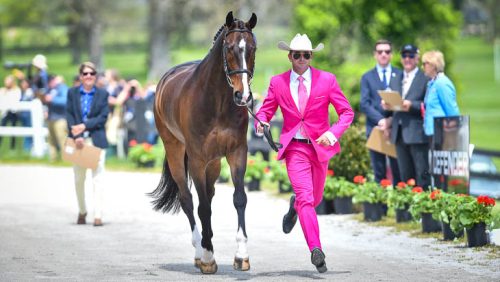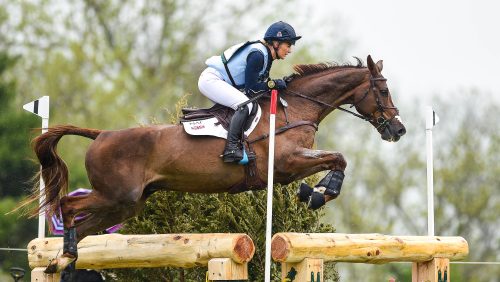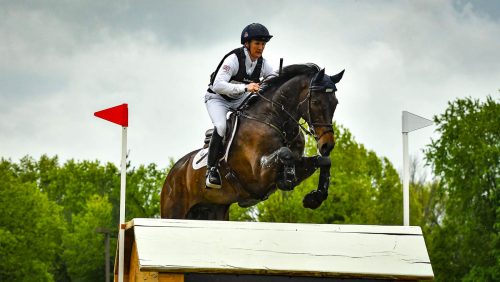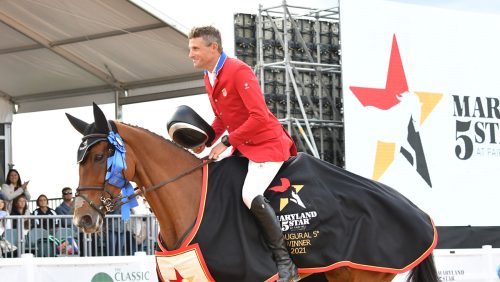The final day of the USEF Training Sessions returned to dressage. While on the first flat day O’Connor established his principles of dressage work as well as ringcraft, it was apparent that on this day he wanted to see the riders consistently execute these concepts. O’Connor’s instruction took on a new level of demand for the riders.
30 Canters And 25 Trots
Sharon White rode Wundermaske for O’Connor and they worked on enhancing the horse’s natural talent. It was apparent that O’Connor sees Wundermaske as very capable, and he pressed White to access all this horse has to offer.
To develop Wundermaske’s gaits, O’Connor made White lower the horse’s frame for four steps, and then raise it again for four steps while maintaining the suppleness. He told White, “The things you are working on are good, but you’re working so much on the details and you still have to remember to push his gaits.”
By lowering the neck and keeping the speed and impulsion, White was able to get Wundermaske to further release his back. When she then went to collect, O’Connor insisted that the speed and impulsion not change. To O’Connor, this exercise is about building options and creating a variety of ranges within each gait. For every horse, he insisted, “I want to have so many different ways to ride them. I want to have 30 canters, 25 trots—not just THE canter and THE trot.”
O’Connor demanded that the riders become more aware of their horse’s tracks. He explained to all the riders spectating that they must watch the horse’s hip and assess straightness. O’Connor noted that most horses carry their haunches to the outside of the track at trot, and often make that shift during the half-halt and lateral work to prevent loading the hind leg properly.
He told riders that when they are riding at this level, such small evasions cannot be tolerated. “Dressage is strengthening,” he reminded them, “and if horses are allowed to be slightly crooked then you will make them stronger crooked.
ADVERTISEMENT
“The true half-halt corrects this,” he explained, “and will allow you to push for correct brilliance.” He said this is the same concept as the horses approaching the fences: they must have a level of correct self-carriage and true connection to be able to press them to the fence and change their shapes.
All sessions incorporated a level of ringcraft, and Sinead Halpin’s session on Manoir de Carneville drilled the turn onto centerline, entrance to shoulder-in, and change at X to half-pass. Every moment of this series of movements was dissected. Halpin was pushed to be able to have “Tate’s” trot balanced and expressive and not to throw away a single step or point.
For O’Connor, good ringcraft is about being proactive. He repeatedly told riders that they seemed too reactive, just reacting to what happens in the ring rather than creating what happens, and that they must have a better plan of execution for every moment of a test.
When Ellen Doughty on Sir Oberon was struggling with her trot lengthenings, he made her stop and discuss the plan for a lengthening. “Extensions have three phases you must ride,” O’Connor said, “1. Create, 2. Support, 3. Push.” He worked with Doughty to have a correct corner so that she should “create” coming out of the corner, “support” the beginning of the lengthening and the balance to X, and then “push” the final steps across the diagonal to get every point.
Repetition is the only way to have consistency. Through every exercise on test movements, O’Connor would have the riders circle and start over if it did not begin correctly. For O’Connor, good scores will come from riding a movement well from start to finish, every time, and not from learning how to correct losses of balance or poorly planned riding during the movement.
Meghan O’Donoghue had one of the last sessions on her own Pirate. O’Connor was thrilled with Pirate’s evolution from Days 1 to 3, exclaiming, “This is a totally different horse than what I saw the other day.” Pirate showed canter work that was “a night and day difference with his hind end,” and their session continued repetition of properly balanced corners.
Rising Professionals
ADVERTISEMENT
To attain the caliber of riding that gets one onto a training list, it is often expected that one needs a barn full of horses, an intense training program, and access to ample funding. I wanted to follow up with three riders in attendance that are debuting at this level and discuss what the training sessions have done for them.
Ellen Doughty made the trip from Texas to ride her own Sir Oberon, who she has come through the ranks with since training level. Doughty explained that these sessions are truly a new thing for her, as she has only been able to take a few lessons and clinics over the past six years. She does not have a regular trainer, and rarely can make these long trips due to expenses.
She mentioned, “it is nice to go to the grocery store and see others in breeches. There’s just so much knowledge and so many good people in this area.” Her horse was a standout to watch and Doughty will be running him at Red Hills (Fla.) before returning to Texas.
Sydney Conley Elliot has been lucky enough to ride with the O’Connors since she was 8, but her location in Louisiana means lots of long trips to compete and minimal access to regular training. Her new horse, Cisko A, was previously campaigned by German rider Dirk Schrade through the CIC** level.
She said, “David can read me like a book, and he knows that with this new horse I have never had the opportunity to have a horse underneath me so well trained. At times,” she continued, “I worry I will undo all his fabulous training.” These sessions instilled in Elliot the importance of “riding the horse” and not to be worried about doing something wrong.
Meghan O’Donoghue is becoming a staple on the training lists after her strong debut with her off-the-track Thoroughbred Pirate at the four-star level. Despite having only one main horse to ride, she is lucky enough to be on both the Under 25 training list and the High Performance training list. “To have the opportunity to partake in the high performance session as a young professional is, first, an honor to get recognition and, second, an extremely educational experience,” O’Donoghue said.
“I tried to immerse myself in the knowledge and take advantage of the chance to be in the situation and compare my progress over the days,” she said. As for the future? “I would like to continue to raise my standard of training as my education expands,” she explained, “and I want to keep taking advantage of my amazing partnership with this horse.”














